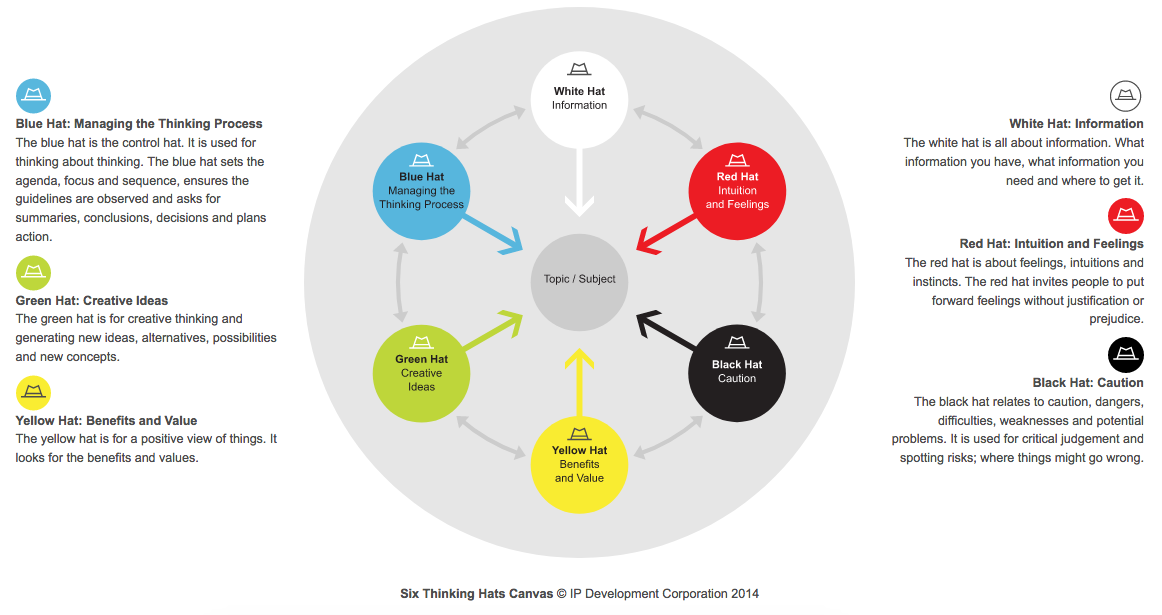Have you ever been in a meeting where no one would agree on a decision? Have you ever struggled to understand why a colleague or someone in your life was always thinking about specific situations in the same patterns, very different than yours? This happened to me more than a few times, and even with the whole empathy in the world, these are moments where one simply wonders: “why is he/she making it more difficult?”
The truth is that everyone has experienced these situations. I remember group conversations where no consensus was found and we wasted one hour of our time talking without a purpose. There are also moments, to this day, where I am not sure I have seen all the ways I can explore a problem to solve it. This lack of knowledge makes me less confident about the choice to make, and as I result I choose not to take a decision. Today, I want to share with you a very useful tool to not only help you improve collaboration in meetings and projects, but also support you in making decisions with strength after having thought about a situation from different perspective. This tool is called the 6 Thinking Hats and it was developed by Edward de Bono, a psychologist who has taught in Oxford, Cambridge and Harvard, among other universities.
The 6 Thinking Hats
The background
This method facilitates collaboration and decision making by having everyone in the group think about the problem in the same way at the same time, and by changing this way of thinking several times to explore all the ways a problem can be approached. This is called parallel thinking as the thoughts of people do not get into conflict and friction with others’ point of view.
How do you do that? By visualising different hats that everyone will wear and that will conduct which way to think about the situation. Someone will own the agenda of the meeting (and will wear the blue hat) (metaphorically, of course) and will clearly establish which hat is being worn and for how long.

At the individual level, it reminds us to see a situation with other perspectives than the one we usually prefer to use.
The hats specifics
Each hat has a different focus:
- White Hat: you focus on the available data. You look at the information that you have, analyze past trends, and see what you can learn from it. You look for gaps in your knowledge, and try to either fill them or take account of them. What are the facts?
- Red Hat: you look at problems using your intuition, gut reaction, and emotion. You think how others could react emotionally and try to understand the responses of people who do not fully know your reasoning.
- Black Hat: you look at a decision’s potentially negative outcomes. It’s the cautious and conservative approach. You try to see why it might not work to highlight the weak points in a plan. It allows you to eliminate them, alter them, or prepare contingency plans to counter them.
- Yellow Hat: you think positively and seek the bright side. It is the optimistic viewpoint that helps you to see all the benefits of the decision and the value in it, and keeps you going when everything looks gloomy and difficult.
- Green Hat: you develop creative solutions to a problem. It is a freewheeling way of thinking, in which there is little criticism of ideas.
- Blue Hat: you look at the big picture and explore what the goal is, what’s the purpose. It’s the hat worn by people who manage the meeting to ensure the guidelines of the thinking hats are met.
De Bono’s website proposes the infographic below to summarise the approach each hat has on a same topic or situation:

How to apply it
1. Whether you are using this method in a group or for yourself, I would recommend to first prepare six pieces of paper with the different hats and their focus. You will be able to fold them, and pick them randomly. In a group setting, measure the time you have available for each hat. It will be easier if you use them for your own as you can decide for yourself.
2. Before starting, decide the goal for the discussion or exploration. What is the aim, the purpose? What do you want to achieve? Write it down.
3. For each hat, write down on a piece of paper or a whiteboard what your thought process is. At the end of the session, you will have six different processes which covered various perspectives of the situation.
4. Now go back to the goal you wrote down. Based on all the information you wrote down for each perspective and all the elements you collected, what appears to be the best decision to make? How do you know it’s the best decision? This will help you circle back the conversation to its original purpose.

